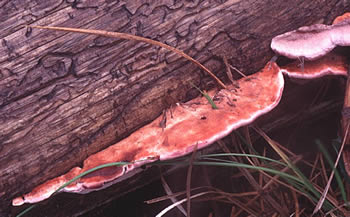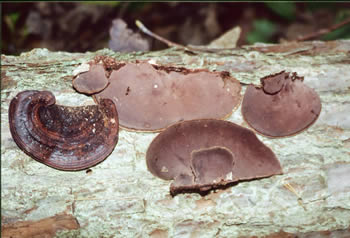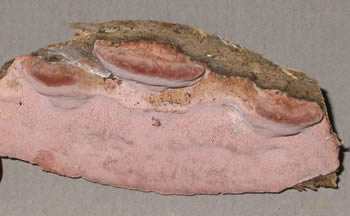Rhodofomes cajanderi
Scientific name: Rhodofomes cajanderi (P. Karst.)
B.K. Cui, M.L. Han & Y.C. Dai
Derivation of name: Rhodo- means "rose" as in
"rose-colored Fomes"; cajanderi indicates the species is
named for Aimo Kaarlo Cajander, a forest ecologist who
also served as Prime Minister of Finland during several
periods of his life.
Synonymy: Fomitopsis cajanderi (P. Karst.) Kotl.
&
Pouzar, Fomes subroseus (Weir) Overh., Trametes
subrosea Weir, Fomes cajanderi Karst.
Common names: Rosy polypore.
Phylum: Basidiomycota
Order: Polyporales
Family: Fomitopsidaceae
Occurrence on wood substrate: Saprobic; solitary to
forming
overlapping clusters on dead conifer wood, rarely
deciduous
wood; year-round.
Dimensions: Caps 2.5-10 cm wide.
Upper surface: Pinkish-red to pinkish gray-brown in age;
finely hairy to glabrous; not cracked.
Pore surface: Rose colored, becoming reddish-brown; 4-5
pores per mm.
Edibility: Inedible.
Comments: See link below to distinguish from Rhodofomes
roseus which
is more hoof-shaped, more boreal or high
elevation in distribution, and has a cracked cap surface in
age. The two species differ microscopically in spore shape.
Both are perennial species.
More information at MushroomExpert.com

Figure 1. Sessile Rhodofomes cajanderi on a log.
Photo © Tom Volk.

Figure 2. Both upper and lower surfaces have a rosy color.
Photo © Larry Grand.

Figure 3. The rosy pore surface of a freshly collected
specimen
of rosy polypore. Photo © Gary Emberger.